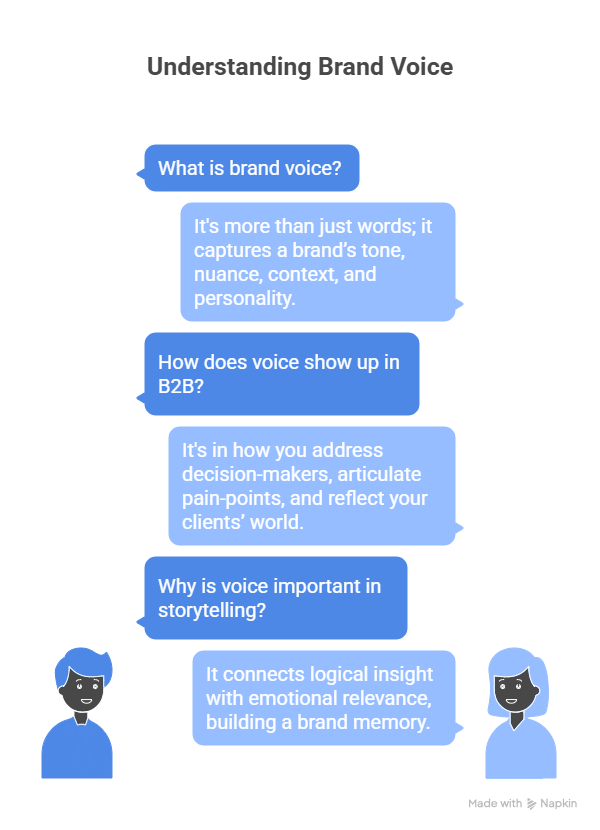Why Does “Authentic Voice” Matter When AI Can Write Almost Anything?
What do we mean by “voice” in marketing and brand communication – tone, nuance, context, personality
In marketing and brand communication, the term “voice” refers to more than just words. It captures a brand’s tone, the nuance behind phrasing, the context in which messages are delivered and the personality implied in every interaction.
In B2B settings, voice shows up in how you address decision-makers, how you articulate pain-points, and how you reflect your clients’ world and point of view. It connects the informational accuracy of your message with emotional resonance and long-term memory.
Storytelling is rarely about facts alone; it is about human connection. A human voice links logical insight with emotional relevance. When a leader reads a white paper or marketing email, they do not simply seek data, but they look for a voice that understands their context, their challenge, and their industry dynamics. That voice builds a brand memory.

How authenticity builds trust, differentiation and brand equity in a noisy landscape
In a fast-moving content environment where many firms publish similar data and insights, authenticity becomes a differentiator. A B2B brand that articulates its voice clearly can build trust.
A IJRAR research in brand authenticity shows that authenticity “is a critical factor in cultivating consumer trust… focusing on a brand’s genuine alignment with its core values, mission, and promises.”
In B2B, where buying cycles are longer, multiple stakeholders are involved and emotional risk is high, trust and brand equity matter more than ever. A consistent human voice signals that the brand understands the buyer’s world, not just making generic claims. That differentiation becomes part of the brand’s identity.
What recent research shows about reader perceptions of machine-generated content
One recent study found that when content is disclosed as AI-generated, perceived authenticity and brand attitude drop even when the text quality is equivalent. Another experiment pointed out that people struggle to distinguish human-written from AI-generated content, raising questions about how authenticity is judged. The implication for brands: even if the machine-generated content is flawless, the perception of authenticity, how “real” or “human” the voice feels, still matters to readers.
Why is it critical to maintain a human element in long-buying-cycle, high-stakes decisions
In B2B environments, your content may guide prospects through complex evaluation, vendor selection, proof-points and case studies. The emotional dimension, ie, the recognition that “you understand my challenge”, “you speak my language”, “we share priorities” – is part of the decision journey. Machine-only content risks sounding too generic and too detached from the prospect's business realities. A strong, authentic voice keeps the human connection alive, reinforcing credibility and relevance across a protracted buying cycle.
If machines can mimic voice, how do we maintain human uniqueness?
What are the risks when authenticity slips into machine-written blandness?
When organisations rely heavily on AI templates, pre-set prompts, standardised phrasing and minimal human customisation, the content can begin to sound the same across multiple brands. That homogenisation undermines brand voice. In marketing, you risk losing the distinct “accent” of your brand – the specific way you express insight, the unique tone you bring to the audience. The outcome: diminished differentiation, weaker brand equity, and less memorability.
Research shows that AI-generated texts often lack an authorial fingerprint and may be perceived as less credible or less authentic
Studies show that AI-generated content is perceived as less authentic and less trustworthy. For example, research indicates that the subtle integration of AI content can reduce perceived authenticity and trust within communities that depend on genuine human connections.
The brand authenticity literature emphasises that authenticity involves emotional, moral, and relational dimensions.
In SEO- and engagement-driven contexts, bland language also impacts dwell time, click-through rates, and trust signals in search or social environments. While I did not locate a public case with full numeric data in a business context, anecdotal reports in agencies suggest a drop in engagement when AI-only copy fails to reflect brand personality.
The strategic risk for CMOs: degraded brand voice, diluted emotional resonance, and weaker performance of content
For CMOs, the strategic risk is that content volume becomes the priority rather than voice quality.
When voice is weakened, two things happen: the emotional resonance that drives memory and preference fades, and the brand voice becomes invisible (so the buyer cannot distinguish your tone from competitors).
The direct consequence is weaker engagement, fewer conversions, and smaller gains in brand equity. The machine becomes the voice rather than the human-machine partnership.
Example: Consider a hypothetical B2B technology services brand deploying AI for content at scale, but finding reduced engagement because the voice sounded generic and disconnected
They adopted an AI-first content engine: blog posts, white papers, and email sequences. The brand saw higher output, but internal metrics showed a decline in read-through rates, fewer shares, and lower qualified leads. On qualitative review, the issue: content lacked client anecdotes, lacked tailored nuance, lacked the brand’s “voice” of direct challenge and problem-solving. The blunt outcome: even though operational costs lowered, effectiveness dropped. The lesson: output alone does not equate to relevance or authenticity.
Authenticity is no longer optional; it is a strategic differentiator.
How is this built when machines assist?
How can human-plus-machine workflows preserve voice rather than erase it?
Model: “Co-creation” workflows where humans set voice, tone, context; machines handle scale, structure, iteration
In this co-creation model, humans define the strategic voice, the persona, and the narrative frame. Machines take on repeatable structure, draft generation, variation and scale. Humans then refine, inject nuance, apply brand personality, and ensure context relevance. Research with professional writers found that many want about “80% me, 20% AI” involvement in their workflow. That ratio preserves voice while leveraging machine efficiency.
5 Practical Steps to Preserve Brand Voice in AI-Assisted Content
- Define your brand voice guidelines - Document tone, vocabulary, sentence style, persona, key phrases, and what to avoid.
- Set clear AI usage guardrails - Decide which content can be AI-drafted and which must stay human-only.
- Keep human editing non-negotiable - Review every AI draft for nuance, context, and brand alignment.
- Train your AI on your voice - Fine-tune prompts and models with your own content, case studies, and phrasing.
- Measure and refine regularly - Audit AI outputs for tone consistency and update your voice guide as your brand evolves.
What capabilities must organisations develop to maintain authenticity at scale?
Data & insight: deep knowledge of customer personas, context, pain-points, language they use (so the “voice” resonates)
An authentic voice connects if it reflects the audience’s reality. That requires deep persona work: what they value, how they phrase challenges, what metaphors they relate to, and what tone they expect.
Data from interviews, field insights, and competitive language audits help build the narrative and set the research's tone. With that foundation, you can infuse your voice into machine-assisted workflows and preserve relevance across scale.
From a systems lens, content architecture matters. Modular frameworks allow sections to be customised for a persona while maintaining brand voice. Reusable blocks (e.g., client quote, insight block, call-to-action) can be templated but use language aligned with the brand persona. At each step, human oversight must check tone, nuance and alignment. Especially microcopy (headlines, CTAs, micro-messages) that often gets automated but may leak generic tone.
Governance is critical for authenticity. It includes:
- Designing prompts that embed voice cues (language style, brand persona, context)
- Fine-tuning or contextualising AI models to brand content rather than raw generic web data
- Maintaining audit trail of AI-assisted content: who edited, what changes were made, and how voice alignment was measured
- Bias mitigation: ensuring AI content does not amplify bias or dilute brand voice by over-relying on common templates
- Region-specific legal compliance around disclosure of AI content (see Chapter 5).
To judge authenticity, we need metrics beyond “words published”. Keep the following pointers in mind while writing your content:
- Internal voice-consistency score: e.g., how many pieces comply with brand voice guidelines (tone, vocabulary, sentence-structure)?
- Engagement metrics: read-through rate, time on page, shares, comments by target audience
- Sentiment analysis: how is content being perceived by the audience (via comments or social listening)
- Brand perception changes: via surveys or brand tracking – is the voice helping differentiate the brand?
- Microcopy performance: conversion of CTAs and response to headlines where the voice is most direct with the user.
What are the ethical and perception challenges around machine-authored content?
Ethical questions surface when content is machine-assisted. Should audiences know? Some research shows disclosure of AI origin can reduce perceived authenticity and weaken brand voice.
Ownership and authorship also matter:
- When does a human claim authorship?
- If the brand voice is machine-generated, who is responsible?
Brands must define disclosure policies, ensure accuracy, and retain human accountability.
The “trust paradox”: as AI becomes more fluent, the risk of misplaced trust or undetected manipulation increases
As AI content becomes harder to distinguish from human writing, the risk of mis- and disinformation grows.
For B2B brands, credibility is non-negotiable. If the brand is perceived as using machines in ways that undermine authenticity, it may degrade its reputation. Any reputable CMS website or research site flags generative AI as a threat to authenticity and trust in communities dependent on human connection
Missing human nuance or context may expose the brand to reputational risk, especially if a large part of the buyer journey depends on trust.
For B2B brands making high-stakes promises, loss of perceived authenticity means loss of credibility. Buyers may question whether the brand truly understands their business or is simply producing generic content at scale. In that case, the brand voice becomes cheapened, and the emotional bond weakens.
While less B2B-centric, examples exist where creative industries certify “human-authored content” to reinforce authenticity. Brands may adopt similar signals: “edited by brand team”, “reviewed by experts”, or “human-led insights”. For B2B marketing leaders this may translate into endorsements, transparency statements or governance disclosures that show human oversight.
Given these challenges, what frameworks help safeguard authenticity?
How can CMOs set up governance and voice frameworks for hybrid human/AI content systems?
CMOs must establish clear roles, such as:
- Brand voice owner (marketing leader) defines voice guidelines and persona language
- An AI content manager (within marketing operations) handles prompt design, model fine-tuning, and performance tracking.
- Content editor team (human) reviews every output before publication.
- The audit and compliance team monitors governance, disclosure, and metrics.
A practical voice framework includes:
- Brand voice guidelines document (tone, vocabulary, sentence length, persona voice)
- Persona language matrix (client segments, how they speak, key metaphors)
- AI prompt templates aligned with brand voice (e.g., “Write a blog for senior marketing leaders in manufacturing… tone: consultative, measured, case-study oriented”)
- Human oversight checkpoints (draft review, voice-audit checklist)
- Microcopy template library (headlines, CTAs, error messages, micro-messages) to ensure brand voice.
What does the future hold for authenticity in the age of generative AI?
Emerging trends: hyper-personalisation at scale, voice fine-tuned models for individual brands, real-time content generation with human-in-the-loop
Future content systems will enable hyper-personalisation: pieces customised by industry, role, region, and pain point, all at scale. Brands will deploy fine-tuned models trained on their own voice, case studies, and micro-copy.
Risk of voice homogenisation across brands if everyone uses the same AI models without differentiation. If every brand uses the same generic AI models and templates without voice customisation, content across the market will sound similar.
Brands may adopt certifications or transparency badges. Ethical obligations will include maintaining authenticity, avoiding misleading claims of human authorship, and ensuring audiences know when AI is involved. This becomes part of brand trust architecture.
Authentic brands that master human-machine collaboration will win
For CMOs, the message is clear: this is not just a tactical content push.
An authentic voice is a strategic asset. Investing now in voice systems, governance, and team capabilities positions you for the future. Brands that wait risk losing voice coherence, differentiation and trust.
Machines will increasingly support content creation, but they cannot replace the human dimension of voice.
Authenticity remains deeply human. The brands that master the workflow where machines assist and humans lead the voice will be those that win in the AI era.
What are the ethical and perception challenges around machine-authored content?
Ethical questions surface when content is machine-assisted. Should audiences know? Some research shows disclosure of AI origin can reduce perceived authenticity and weaken brand voice.
Ownership and authorship also matter:
- When does a human claim authorship?
- If the brand voice is machine-generated, who is responsible?
Brands must define disclosure policies, ensure accuracy, and retain human accountability.
The “trust paradox”: as AI becomes more fluent, the risk of misplaced trust or undetected manipulation increases
As AI content becomes harder to distinguish from human writing, the risk of mis- and disinformation grows.
For B2B brands, credibility is non-negotiable. If the brand is perceived as using machines in ways that undermine authenticity, it may degrade its reputation. Any reputable CMS website or research site flags generative AI as a threat to authenticity and trust in communities dependent on human connection
Missing human nuance or context may expose the brand to reputational risk, especially if a large part of the buyer journey depends on trust.
For B2B brands making high-stakes promises, loss of perceived authenticity means loss of credibility. Buyers may question whether the brand truly understands their business or is simply producing generic content at scale. In that case, the brand voice becomes cheapened, and the emotional bond weakens.
While less B2B-centric, examples exist where creative industries certify “human-authored content” to reinforce authenticity. Brands may adopt similar signals: “edited by brand team”, “reviewed by experts”, or “human-led insights”. For B2B marketing leaders this may translate into endorsements, transparency statements or governance disclosures that show human oversight.
Given these challenges, what frameworks help safeguard authenticity?
How can CMOs set up governance and voice frameworks for hybrid human/AI content systems?
CMOs must establish clear roles, such as:
- Brand voice owner (marketing leader) defines voice guidelines and persona language
- An AI content manager (within marketing operations) handles prompt design, model fine-tuning, and performance tracking.
- Content editor team (human) reviews every output before publication.
- The audit and compliance team monitors governance, disclosure, and metrics.
A practical voice framework includes:
- Brand voice guidelines document (tone, vocabulary, sentence length, persona voice)
- Persona language matrix (client segments, how they speak, key metaphors)
- AI prompt templates aligned with brand voice (e.g., “Write a blog for senior marketing leaders in manufacturing… tone: consultative, measured, case-study oriented”)
- Human oversight checkpoints (draft review, voice-audit checklist)
- Microcopy template library (headlines, CTAs, error messages, micro-messages) to ensure brand voice.
What does the future hold for authenticity in the age of generative AI?
Emerging trends: hyper-personalisation at scale, voice fine-tuned models for individual brands, real-time content generation with human-in-the-loop
Future content systems will enable hyper-personalisation: pieces customised by industry, role, region, and pain point, all at scale. Brands will deploy fine-tuned models trained on their own voice, case studies, and micro-copy.
Risk of voice homogenisation across brands if everyone uses the same AI models without differentiation. If every brand uses the same generic AI models and templates without voice customisation, content across the market will sound similar.
Brands may adopt certifications or transparency badges. Ethical obligations will include maintaining authenticity, avoiding misleading claims of human authorship, and ensuring audiences know when AI is involved. This becomes part of brand trust architecture.
Authentic brands that master human-machine collaboration will win
For CMOs, the message is clear: this is not just a tactical content push.
An authentic voice is a strategic asset. Investing now in voice systems, governance, and team capabilities positions you for the future. Brands that wait risk losing voice coherence, differentiation and trust.
Machines will increasingly support content creation, but they cannot replace the human dimension of voice.
Authenticity remains deeply human. The brands that master the workflow where machines assist and humans lead the voice will be those that win in the AI era.
Do you want more traffic?

How to Scale Personalisation in ABM Without Losing Focus?
.png)
Why Small Tasks Are the Next Big Revolution in Business Efficiency?







.jpeg)



